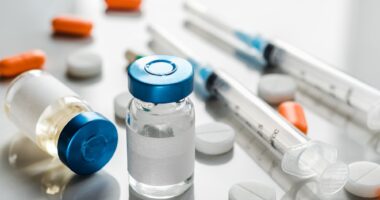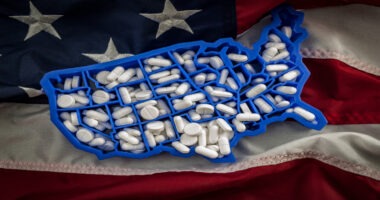Tracking the Fortunes of Solid Dosage Products
Despite increased penetration of biologics and small-molecules delivered via parenterally or in other routes, solid dosage products remain an important part of the overall drug market and among new molecular entities. So what has been the penetration of solid dosage products among new molecular entities and how does this compare to recent levels?DCAT Value Chain Insights (VCI) examines the key trends.
In looking at recent new drug approvals, in 2014, 46% of the new molecular entities (NMEs) approved by the US Food and Drug Administration’s (FDA) Center for Drug Evaluation and Research (CDER) were solid dosage products (tablets or capsules). So how is this trending with recent years?
Solid dosage products in the pharma market
In looking at recent trends, solid dosage products accounted for an important and fairly constant to slightly declining share of the industry’s top-selling products. Of the top 20 selling drugs on a global basis in 2014, six products or 30% were solid dosage products, down from eight products in 2013. In 2014, the global pharmaceutical market was valued at $936.5 billion (based on December 2014 estimates including prescription and certain over-the-counter products at manufacturers’ prices), according to IMS Health. Of this total, the six products that were solid dosage products (including products that may have been sold in both solid dosage and other dosage forms) accounted for $45.8 billion. This six products were Gilead Sciences’ Solvaldi (sofosbuvir), Bristol-Myers Squibb’s Abilify (aripiprazole); AstraZeneca’s Nexium (esomeprazole) and Crestor (rosovastatin); Pfizer’s Lyrica (pregabalin) and Merck & Co.’s Januvia (sitagliptin);
Of the top 20 selling prescription drugs on a global basis in 2013, eight products, or 40%, were solid dosage products. Based on IMS estimates, the the global market accounted for$874.6 billion in sales (based on December 2013 estimates, calculated using US dollars with quarterly exchange rates and including direct and indirect pharmaceutical channels: wholesalers and manufacturers). Of this total, the eight products with solid dosage forms (which also included actives produced in solid dosage forms and other approved dosage forms) accounted for $48.04 billion (see Table I). These products were: AstraZeneca’s Nexium (esomeprazole) and Crestor (rosovastatiny); Bristol-Myers Squibb’s Abilify (aripiprazole); Eli Lilly’s Cymbalta (duloxetine); Gilead Sciences’ Atripla (efavirenz, emtricitabine, and tenofovir disoproxil fumarate); Merck & Co.’s Januvia (sitagliptin); Novartis’ Gleevec/Glivec (imatinib); and Pfizer’s Lyrica (pregabalin).
In looking at new drug approvals in 2014 and 2013, 46% of the new molecular entities (NMEs) approved CDER in 2014 were solid dosage products, and 63% of the NMEs approved in 2013 were solid dosage products (see Tables II and III at end of article). In 2014, 19 of the 41 NMEs were solid dosage products. Ten were approved as tablets and nine as capsules. In 2013, 17 of the 27 NMEs approved were solid dosage products. Twelve products were approved as tablets and five as capsules (see Tables II and III at end of article).
| Table I: Top-Selling Solid Dosage Products* in 2013, Global Prescription Products | |||
| Company | Proprietary Name (Active Iingredient) | Indication | FDA-Approved Dosage Forms |
| AstraZeneca | Crestor (rosovastatin) | To lower cholesterol | Tablet |
| AstraZeneca | Nexium (esomeprazole) | Gastroesophageal reflux disease and stomach ulcers | Capsule, delayed-release pellets and suspension, delayed release (oral) |
| Bristol-Myers Squibb | Abilify (aripiprazole) | Schizophrenia, bipolar disorder, and depression | Tablet; tablet (orally disintegrating); solution (oral); and injection (intramuscular) |
| Eli Lilly and Company | Cymbalta (duloxetine hydrochloride) | Depression, anxiety, diabetic peripheral neuropathy, fibromyalgia, or chronic muscle or bone pain | Capsule, delayed-release pellets |
| Gilead Sciences | Atripla (efavirenz, emtricitabine, and tenofovir disoproxil fumarate) | HIV infection | Tablet |
| Merck & Co. | Januvia (sitagliptin) | Type II diabetes | Tablet |
| Novartis | Gleevec/Glivec (imatinib) | Certain types of leukemia. Also treats gastrointestinal stromal tumor myelodysplastic syndrome or myeloproliferative disease, aggressive systemic mastocytosis , hypereosinophilic syndrome , and dermatofibrosarcoma protuberans | Tablet and capsule |
| Pfizer | Lyrica (pregabalin) | Nerve and muscle pain caused by diabetes, shingles, fibromyalgia, or a spinal cord injury. Also treats partial-onset seizures in adults. | Capsule and solution (oral) |
| Source: Top-selling products compiled from IMS Midas (December 2013). Sales were calculated using US dollars with quarterly exchange rates and including direct and indirect pharmaceutical channels: wholesalers and manufacturers.
Active ingredient, indication, and dosage form taken from Drugs@FDA, US Food and Drug Administration, Center for Drug Evaluation and Research. |
|||
Among the large pharmaceutical companies, NME approvals in 2014 with solid dosage forms included: AbbVie’s Viekira Pak (ombitasvir, paritaprevir and ritonavir tablets co-packaged with dasabuvir tablets) to treat chronic hepatitis C virus infection; AstraZeneca’s Farxiga (dapaglifozin) for treating Type 2 diabetes, Movantik (naloxegel), a drug to treat opioid-induced constipation in adults with chronic non-cancer pain, and Lynparza (olaparib) for treating advanced ovarian cancer; Boehringer Ingelheim’s Ofev (nintedanib) for treating idiopathic pulmonary fibrosis and Jardiance (empagliflozin) for treating Type 2 diabetes, a drug which is part of Boehringer Ingelheim’s diabetes alliance with Eli Lilly; Gilead Sciences’ Harvoni (ledipasvir and sofosbuvir) for treating chronic hepatitis C virus genotype 1 infection and Zydelig (idelalisib) for treating three types of blood cancer; Merck & Co.’s Belsomra (suvorexant) for treating insomnia and Zontivity (vorapaxar), an antiplatelet; Novarti’s Zykadia (ceritinib), for treating a certain type of metastatic non-small cell lung cancer; Roche, through its acquisition of InterMune earlier in 2014, for Esbriet (pirfenidone) for treating idiopathic pulmonary fibrosis; and Sanofi’s Cerdelga (eliglustat) for the long-term treatment of adult patients with the Type I form of Gaucher disease, a rare genetic disorder.
A drug’s product form is an important consideration in the drug’s marketability and commercialization, a point that was underscored by one of the top-selling drugs in 2014: Gilead Sciences’ Sovaldi (sofosbuvir), the company’s oral drug to treat chronic hepatitis C virus (HCV) infection. Sovaldi, which was approved by the FDA in December 2013 and in the European Union in January 2014, was the first drug that demonstrated safety and efficacy to treat certain types of HCV infection without the need for co-administration of interferon, which is administered by injection. Sovaldi is a nucleotide analog inhibitor that blocks a specific protein needed by the hepatitis C virus to replicate, and that mechanism of action was considered an important advancement as well as the ability to administer the drug orally. Sovaldi was Gilead’s top-selling drug in 2014 and was one of the industry’s top-selling drugs with 2014 sales of $10.28 billion, making it one of the most successful first-year launches for a NME.
| Table II: Solid Dosage Products Approved as New Molecular Entities by the US Food and Drug Administration’s Center for Drug Evaluation and Research, 2014 |
|||
| Company | Property Name (Active Ingredient) |
Indication | FDA-Approved Dosage Forms |
| AbbVie | Viekira Pak (ombitasvir, paritaprevir and ritonavir tablets co-packaged with dasabuvir tablets) | Chronic hepatitis C virus genotype 1 infection, including those with cirrhosis | Tablet |
| AstraZeneca | Farxiga (dapaglifozin) | To improve glycemic control, along with diet and exercise, in adults with Type 2 diabetes | Tablet |
| AstraZeneca | Movantik (naloxegol) | Opioid-induced constipation in adults with chronic non-cancer pain | Tablet |
| AstraZeneca | Lynparza (olaparib) | Advanced ovarian cancer | Capsule |
| Boehringer Ingelheim | Ofev (nintedanib) | Idiopathic pulmonary fibrosis | Capsule |
| Boehringer Ingelheim | Jardiance (empagliflozin) | To improve gylcemic control in adults with Type 2 diabetes | Tablet |
| Celgene | Otezla (apremilast) | To treat adults with active psoriatic arthritis | Tablet |
| Cubist Pharmaceuticals | Sivextro (tedizolid phosphate) | Acute bacterial skin and skin structure infections | Tablet |
| Gilead Sciences | Harvoni (ledipasvir and sofosbuvir) | Chronic hepatitis C virus genotype 1 infection | Tablet |
| Gilead Sciences | Zydelig (idelalisib) | To treat three types of blood cancer | Tablet |
| Helsinn Healthcare | Akynzeo (netupitant and palonosetron) |
To treat nausea and vomiting in patients undergoing cancer chemotherapy | Capsule |
| Lundbeck/Chelsea Therapeutics | Northera (droxidupa) | Neurogenic orthostatic hypotension | Capsule |
| Knight Therapeutics | Impavido (miltefosine) | Leishmaniasis | Capsule |
| Merck & Co. Inc. | Belsomra (suvorexant) | To treat difficulty in falling and staying asleep (insomnia) | Tablet |
| Merck & Co. Inc. | Zontivity (vorapaxar) | To reduce the risk of heart attack, stroke, cardiovascular death, and need for procedures to restore blood flow to the heart in patients with a previous heart attack or blockages in the arteries to the legs | Tablet |
| Novartis | Zykadia (ceritinib) | A certain type of metastatic non-small cell lung cancer | Capsule |
| Roche/InterMune | Esbriet (pirfenidone) | Idiopathic pulmonary fibrosis | Capsule |
| Sanofi/Genzyme | Cerdelga (eliglustat) | Long-term treatment of adult patients with the Type 1 form of Gaucher disease | Capsule |
| Vanda Pharmaceuticals | Hetlioz (tasimelteon) | To treat non-24-hour sleepwake disorder in blind individuals without light perception | Capsule |
| AstraZeneca completed the acquisition of its diabetes alliance from Bristol-Myers, in February 2014, which include Farxiga (dapagliflozin) and related payments to Bristol-Myers Squibb.
Akynzeo is distributed and marketed by Eisai Inc. of Woodcliff Lake, New Jersey, under license from Lugano, Switzerland-based Helsinn Healthcare S.A. Cubist Pharmaceuticals’ Sivextro (tedizolid phosphate) is also approved as a powder for administering via IV (infusion). Merck & Co. acquired Cubist Pharmaceuticals in 2015. Knight Therapeutics Inc. was formed from the former shareholders of Paladin Labs Inc pursuant to a spin-off transaction made in February 2014; Paladin was acquired by Endo Health Solutions Inc., a specialty pharmaceutical company. Roche acquired InterMune in 2014. |
|||
| Table III: Solid Dosage Products Approved as New Molecular Entities by the US Food and Drug Administration’s Center for Drug Evaluation and Research, 2013 |
|||
| Company | Proprietary Name (Active Ingredient) |
Indication | FDA-Approved Dosage Forms |
| Actelion Pharmaceuticals | Opsumit (macitentan) | Pulmonary arterial hypertension | Tablet |
| Bayer Healthcare | Adempas (riociguat) | Two forms of pulmonary hypertension | Tablet |
| Biogen Idec | Tecfidera (dimethyl fumarate) | Relapsing forms of multiple sclerosis | Capsule, delayed release |
| Boehringer Ingelheim | Gilotrif (afatinib dimaleate) | Metastatic non-small cell lung cancer with specific types of epidermal growth factor receptor gene mutation as detected by an FDA-approved test. | Tablet |
| Celgene | Pomalyst (pomalidomide) | Multiple myeloma | Capsule |
| Gilead Sciences | Sovaldi (sofosbuvir) | Chronic hepatitis C virus infection | Tablet |
| Janssen Biotech and Pharmacyclics* | Imbruvica (ibrutinib)** | Mantle cell lymphoma | Capsule |
| Janssen Pharmaceuticals | Invokana (canagliflozin) | Used with diet and exercise, to improve glycemic control in adults with Type 2 diabetes | Tablet |
| Janssen Pharmaceuticals | Olysio (simeprevir sodium) | Chronic hepatitis C virus infection. | Capsule |
| Novartis** | Tafinlar (dabrafenib mesylate | Advanced melanoma with BRAF V600E mutation as detected by an FDA-approved test | Capsule |
| Novartis** | Mekinist (trametinib dimethyl sulfoxide) | In combination with tafinlar for advanced melanoma with BRAF V600E mutation as detected by an FDA-approved test | Tablet |
| Pfizer | Duavee (bazedoxifene acetate; estrogens, conjugated); new combination | Moderate-to-severe hot flashes associated with menopause and to prevent osteoporosis after menopause | Tablet |
| Shionogi | Osphena (ospemifene) | Moderate to severe dyspareunia | Tablet |
| Sunovion Pharmaceuticals | Aptiom (eslicarbazepine acetate) | An add-on medication to treat seizures associated with epilepsy | Tablet |
| Takeda Pharmaceuticals | Brintellix (vortioxetine hydrobromide) | Major depressive disorder | Tablet |
| Takeda Pharmaceuticals | Nesina (alogliptin benzoate) | To improve blood sugar control in adults with Type 2 diabetes. | Tablet |
| ViiV Healthcare | Tivicay (dolutegravir sodium | HIV-1 infection | Tablet |
| *Janssen Biotech’s and Pharmacyclics’s Imbruvica (ibrutinib) also was later approved to treat chronic lymphocytic leukemia and Waldenstrom’s macroglobulinemia.
In March 2015, AbbVie agreed to acquire Pharmacyclics for $21 billion; the deal later closed in 2015. Janssen Biotech and Janssen Pharmaceuticals are part of Johnson & Johnson. **Novartis acquired GlaxoSmithKline’s oncology portfolio, including Tafinlar and Mekinist in March 2015. Source: US Food and Drug Administration’s Center for Drug Evaluation and Research and company information. |
|||





